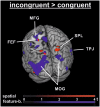The effect of feature-based attention on flanker interference processing: An fMRI-constrained source analysis
- PMID: 29371681
- PMCID: PMC5785471
- DOI: 10.1038/s41598-018-20049-1
The effect of feature-based attention on flanker interference processing: An fMRI-constrained source analysis
Abstract
The present study examined whether feature-based cueing affects early or late stages of flanker conflict processing using EEG and fMRI. Feature cues either directed participants' attention to the upcoming colour of the target or were neutral. Validity-specific modulations during interference processing were investigated using the N200 event-related potential (ERP) component and BOLD signal differences. Additionally, both data sets were integrated using an fMRI-constrained source analysis. Finally, the results were compared with a previous study in which spatial instead of feature-based cueing was applied to an otherwise identical flanker task. Feature-based and spatial attention recruited a common fronto-parietal network during conflict processing. Irrespective of attention type (feature-based; spatial), this network responded to focussed attention (valid cueing) as well as context updating (invalid cueing), hinting at domain-general mechanisms. However, spatially and non-spatially directed attention also demonstrated domain-specific activation patterns for conflict processing that were observable in distinct EEG and fMRI data patterns as well as in the respective source analyses. Conflict-specific activity in visual brain regions was comparable between both attention types. We assume that the distinction between spatially and non-spatially directed attention types primarily applies to temporal differences (domain-specific dynamics) between signals originating in the same brain regions (domain-general localization).
Conflict of interest statement
The authors declare that they have no competing interests.
Figures





References
-
- Allport DA. Parallel encoding within and between elementary stimulus dimensions. Perception & psychophysics. 1971;10:104–108. doi: 10.3758/BF03214327. - DOI
-
- Polk TA, Drake RM, Jonides JJ, Smith MR, Smith EE. Attention enhances the neural processing of relevant features and suppresses the processing of irrelevant features in humans: a functional magnetic resonance imaging study of the Stroop task. J. Neurosci. 2008;28:13786–13792. doi: 10.1523/JNEUROSCI.1026-08.2008. - DOI - PMC - PubMed
Publication types
MeSH terms
LinkOut - more resources
Full Text Sources
Other Literature Sources

